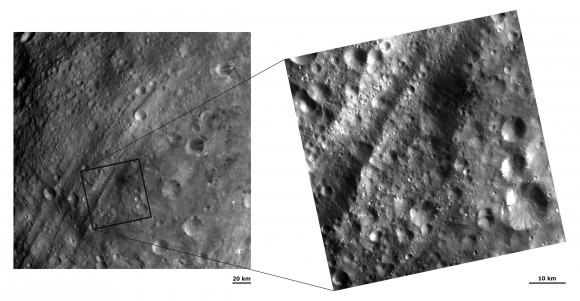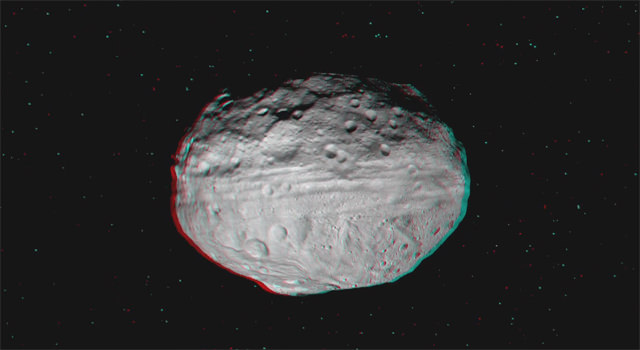When NASA’s Dawn spacecraft arrived at Vesta in July 2011, two features immediately jumped out at planetary scientists who had been so eagerly anticipating a good look at the giant asteroid. One was a series of long troughs encircling Vesta’s equator, and the other was the enormous crater at its southern pole. Named Rheasilvia, the centrally-peaked basin spans 500 kilometers in width and it was hypothesized that the impact event that created it was also responsible for the deep Grand Canyon-sized grooves gouging Vesta’s middle.
Now, research led by a Brown University professor and a former graduate student reveal how it all probably happened.
“Vesta got hammered,” said Peter Schultz, professor of earth, environmental, and planetary sciences at Brown and the study’s senior author. “The whole interior was reverberating, and what we see on the surface is the manifestation of what happened in the interior.”
Using a 4-meter-long air-powered cannon at NASA’s Ames Vertical Gun Range, Peter Schultz and Brown graduate Angela Stickle – now a researcher at the Johns Hopkins University Applied Physics Laboratory – recreated cosmic impact events with small pellets fired at softball-sized acrylic spheres at the type of velocities you’d find in space.
The impacts were captured on super-high-speed camera. What Stickle and Schultz saw were stress fractures occurring not only at the points of impact on the acrylic spheres but also at the point directly opposite them, and then rapidly propagating toward the midlines of the spheres… their “equators,” if you will.
Scaled up to Vesta size and composition, these levels of forces would have created precisely the types of deep troughs seen today running askew around Vesta’s midsection.
Watch a million-fps video of a test impact below:
So why is Vesta’s trough belt slanted? According to the researchers’ abstract, “experimental and numerical results reveal that the offset angle is a natural consequence of oblique impacts into a spherical target.” That is, the impactor that struck Vesta’s south pole likely came in at an angle, which made for uneven propagation of stress fracturing outward across the protoplanet (and smashed its south pole so much that scientists had initially said it was “missing!”)

That angle of incidence — estimated to be less than 40 degrees — not only left Vesta with a slanted belt of grooves, but also probably kept it from getting blasted apart altogether.
“Vesta was lucky,” said Schultz. “If this collision had been straight on, there would have been one less large asteroid and only a family of fragments left behind.”
Watch a video tour of Vesta made from data acquired by Dawn in 2011 and 2012 below:
The team’s findings will be published in the February 2015 issue of the journal Icarus and are currently available online here (paywall, sorry). Also you can see many more images of Vesta from the Dawn mission here and find out the latest news from the ongoing mission to Ceres on the Dawn Journal.
Source: Brown University news


Only one glaring problem, as I picture this explanation. A slanting strike of this magnitude would have set Vesta rotating so that what we know as the north and south poles would then have laid along the line of the the new equator. The actual poles would then be located along the line of the present equator, perpendicular to the direction of the slanting impact.